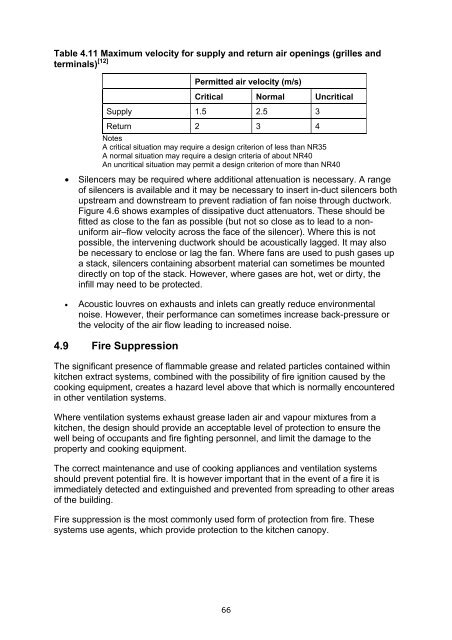Guidance on the Control of Odour and Noise from ... - Defra
Guidance on the Control of Odour and Noise from ... - Defra
Guidance on the Control of Odour and Noise from ... - Defra
Create successful ePaper yourself
Turn your PDF publications into a flip-book with our unique Google optimized e-Paper software.
Table 4.11 Maximum velocity for supply <strong>and</strong> return air openings (grilles <strong>and</strong><br />
terminals) [12]<br />
Permitted air velocity (m/s)<br />
Critical Normal Uncritical<br />
Supply 1.5 2.5 3<br />
Return 2 3 4<br />
Notes<br />
A critical situati<strong>on</strong> may require a design criteri<strong>on</strong> <strong>of</strong> less than NR35<br />
A normal situati<strong>on</strong> may require a design criteria <strong>of</strong> about NR40<br />
An uncritical situati<strong>on</strong> may permit a design criteri<strong>on</strong> <strong>of</strong> more than NR40<br />
• Silencers may be required where additi<strong>on</strong>al attenuati<strong>on</strong> is necessary. A range<br />
<strong>of</strong> silencers is available <strong>and</strong> it may be necessary to insert in-duct silencers both<br />
upstream <strong>and</strong> downstream to prevent radiati<strong>on</strong> <strong>of</strong> fan noise through ductwork.<br />
Figure 4.6 shows examples <strong>of</strong> dissipative duct attenuators. These should be<br />
fitted as close to <strong>the</strong> fan as possible (but not so close as to lead to a n<strong>on</strong>uniform<br />
air–flow velocity across <strong>the</strong> face <strong>of</strong> <strong>the</strong> silencer). Where this is not<br />
possible, <strong>the</strong> intervening ductwork should be acoustically lagged. It may also<br />
be necessary to enclose or lag <strong>the</strong> fan. Where fans are used to push gases up<br />
a stack, silencers c<strong>on</strong>taining absorbent material can sometimes be mounted<br />
directly <strong>on</strong> top <strong>of</strong> <strong>the</strong> stack. However, where gases are hot, wet or dirty, <strong>the</strong><br />
infill may need to be protected.<br />
• Acoustic louvres <strong>on</strong> exhausts <strong>and</strong> inlets can greatly reduce envir<strong>on</strong>mental<br />
noise. However, <strong>the</strong>ir performance can sometimes increase back-pressure or<br />
<strong>the</strong> velocity <strong>of</strong> <strong>the</strong> air flow leading to increased noise.<br />
4.9 Fire Suppressi<strong>on</strong><br />
The significant presence <strong>of</strong> flammable grease <strong>and</strong> related particles c<strong>on</strong>tained within<br />
kitchen extract systems, combined with <strong>the</strong> possibility <strong>of</strong> fire igniti<strong>on</strong> caused by <strong>the</strong><br />
cooking equipment, creates a hazard level above that which is normally encountered<br />
in o<strong>the</strong>r ventilati<strong>on</strong> systems.<br />
Where ventilati<strong>on</strong> systems exhaust grease laden air <strong>and</strong> vapour mixtures <strong>from</strong> a<br />
kitchen, <strong>the</strong> design should provide an acceptable level <strong>of</strong> protecti<strong>on</strong> to ensure <strong>the</strong><br />
well being <strong>of</strong> occupants <strong>and</strong> fire fighting pers<strong>on</strong>nel, <strong>and</strong> limit <strong>the</strong> damage to <strong>the</strong><br />
property <strong>and</strong> cooking equipment.<br />
The correct maintenance <strong>and</strong> use <strong>of</strong> cooking appliances <strong>and</strong> ventilati<strong>on</strong> systems<br />
should prevent potential fire. It is however important that in <strong>the</strong> event <strong>of</strong> a fire it is<br />
immediately detected <strong>and</strong> extinguished <strong>and</strong> prevented <strong>from</strong> spreading to o<strong>the</strong>r areas<br />
<strong>of</strong> <strong>the</strong> building.<br />
Fire suppressi<strong>on</strong> is <strong>the</strong> most comm<strong>on</strong>ly used form <strong>of</strong> protecti<strong>on</strong> <strong>from</strong> fire. These<br />
systems use agents, which provide protecti<strong>on</strong> to <strong>the</strong> kitchen canopy.<br />
66
















